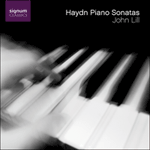Roughly contemporary with the string quartets of Op 17 and Op 20, No 44 and No 20 are the earliest works Haydn designated ‘sonata’ rather than ‘divertimento’. Both recreate the spirit of Emanuel Bach’s Empfindsamkeit in terms of Haydn’s own more dynamic, ‘goal-oriented’ idiom. No 44 in G minor, in just two movements, exudes a melancholy intimacy unique among his sonatas. Its opening movement, permeated by the main theme’s initial triplet upbeat, rises to a magnificent, densely textured contrapuntal climax in the development; and the delicately ornamental G minor/major minuet sublimates galant gestures into pure pathos. Haydn embellishes the repeat of the G minor section, à la Emanuel Bach, and then introduces a truncated version of the G major trio (itself a variant of the G minor theme) as a coda.
from notes by Richard Wigmore © 2012
À peu près contemporaines des quatuors à cordes des opp. 17 et 20, les nos 44 et 20 sont les toute premières œuvres que Haydn appela «sonate» et non «divertimento». Toutes deux recréent l’esprit de l’Empfindsamkeit d’Emanuel Bach dans l’idiome plus dynamique, plus «tourné vers un but» de Haydn. La nº 44 en sol mineur, en seulement deux mouvements, exsude une intimité mélancolique unique dans les sonates haydniennes. Son mouvement inaugural, empreint du levé en triolet initial du thème principal, atteint, dans le développement, à un magnifique apogée contrapuntique, dense de texture; et le menuet en sol mineur/majeur, subtilement ornemental, sublime les gestes galants en pur pathos. Haydn embellit la répétition de la section en sol mineur, à la Emanuel Bach, avant d’introduire, en guise de coda, une version tronquée du trio en sol majeur (variante du thème en sol mineur).
extrait des notes rédigées par Richard Wigmore © 2012
Français: Hypérion
Etwa aus der gleichen Zeit wie die Streichquartette op. 17 und op. 20 stammen die Werke Nr. 44 und Nr. 20—die ersten, welche Haydn nicht mehr als „Divertimento“, sondern als „Sonate“ bezeichnete. Beide übersetzen den Geist von Emanuel Bachs Empfindsamkeit in Haydns dynamischere, stärker „zielorientierte“ Musiksprache. Die nur zweisätzige Nr. 44 in g-Moll verströmt eine melancholische Innigkeit, die in Haydns Sonatenschaffen einzigartig ist. Ihr Kopfsatz, der immer wieder die anfängliche Auftakttriole des Hauptthemas erklingen lässt, steigert sich in der Durchführung zu einem prachtvollen und kontrapunktisch dicht gewobenen Höhepunkt; im vorsichtig verzierten Menuett in g-Moll/ G-Dur werden galante Gesten in höchstes Pathos verwandelt. Die Wiederholung des g-Moll-Abschnitts schmückt Haydn nach Art von Emanuel Bach aus, dann lässt er eine verkürzte Fassung des G-Dur-Trios (selbst eine Variante des Mollthemas) als Coda folgen.
aus dem Begleittext von Richard Wigmore © 2012
Deutsch: Arne Muus


 Haydn: Piano Sonatas
Haydn: Piano Sonatas
